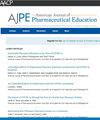药学教育行动呼吁的范围审查。
IF 3.8
4区 教育学
Q1 EDUCATION, SCIENTIFIC DISCIPLINES
引用次数: 0
摘要
目的:药学教育中的行动呼吁经常出现在文献中,很少有关于其作者,受众和重点的信息,特别是这些呼吁是否导致了任何变化。该范围审查旨在(1)定量和定性地描述药学教育中的行动呼吁,(2)检查与有效倡导相关的已发表文章的特征。研究结果:使用系统评价和荟萃分析的首选报告项目进行了范围评价的系统文献检索。从3287篇文章中,包括232篇文章,并根据其具体的行动呼吁(如主题、受众和呼吁质量)进行提取。三分之二(66.7%)的电话是由教师团体发起的,49%是评论/意见/社论,39%集中在药学博士课程上。超过90%的文章发表于2013-2023年之间,仅2023年就有26%的文章发表。大多数电话是打给药学院的(81%)。只有21%的文章强烈呼吁采取下一步行动或提出实施变革的建议。总结:最常发表的行动呼吁与药学博士课程有关,由一组教师撰写,针对药学博士项目,并在大流行后年份发表,但往往不足以引起变化。为了唤起变革,行动呼吁应该包括基于范围审查的几个关键特征,例如以积极的语气写的,针对特定的受众,清楚地陈述问题,以及可以实施的可操作的解决方案。本文章由计算机程序翻译,如有差异,请以英文原文为准。
A Scoping Review of Calls to Action in Pharmacy Education
Objectives
Calls to action in pharmacy education are frequently observed in the literature, with little information about their authors, audience, or focus, especially regarding whether these calls led to any changes. This scoping review aims to (1) quantitatively and qualitatively characterize the calls to action in pharmacy education and (2) examine the traits of published articles typically associated with effective advocacy.
Findings
A systematic literature search for the scoping review was conducted using the PRISMA Preferred Reporting Items for Systematic Reviews and Meta-Analyses guidelines. Of 3287 articles, 232 were included and extracted for their specific call to action, including topics, audience, and call quality. Two-thirds (66.7%) of the calls were initiated by faculty groups, 49% were commentaries, opinions, or editorials, and 39% were focused on the Doctor of Pharmacy curriculum. More than 90% of the articles were published between 2013 and 2023, with 26% published in 2023 alone. Most calls were directed to colleges/schools of pharmacy (81%). Only 21% of articles had a strong call to action with next steps or recommendations for enacting change.
Summary
The most frequently published calls to action were related to the pharmacy curriculum, authored by faculty groups, directed to pharmacy programs, and published in the postpandemic years, but were often not sufficiently strong to elicit change. To evoke change, calls to action should include several key characteristics according to this scoping review, such as being written in active voice, to a specific audience, with clearly stated problems, and with actionable solutions that could be implemented.
求助全文
通过发布文献求助,成功后即可免费获取论文全文。
去求助
来源期刊
CiteScore
4.30
自引率
15.20%
发文量
114
期刊介绍:
The Journal accepts unsolicited manuscripts that have not been published and are not under consideration for publication elsewhere. The Journal only considers material related to pharmaceutical education for publication. Authors must prepare manuscripts to conform to the Journal style (Author Instructions). All manuscripts are subject to peer review and approval by the editor prior to acceptance for publication. Reviewers are assigned by the editor with the advice of the editorial board as needed. Manuscripts are submitted and processed online (Submit a Manuscript) using Editorial Manager, an online manuscript tracking system that facilitates communication between the editorial office, editor, associate editors, reviewers, and authors.
After a manuscript is accepted, it is scheduled for publication in an upcoming issue of the Journal. All manuscripts are formatted and copyedited, and returned to the author for review and approval of the changes. Approximately 2 weeks prior to publication, the author receives an electronic proof of the article for final review and approval. Authors are not assessed page charges for publication.

 求助内容:
求助内容: 应助结果提醒方式:
应助结果提醒方式:


